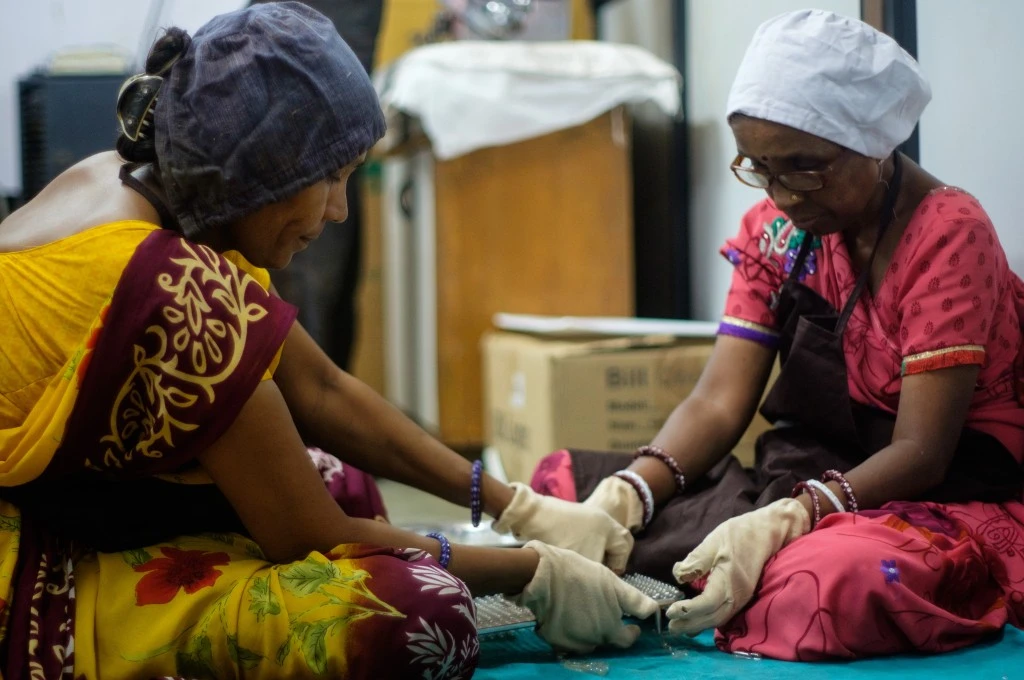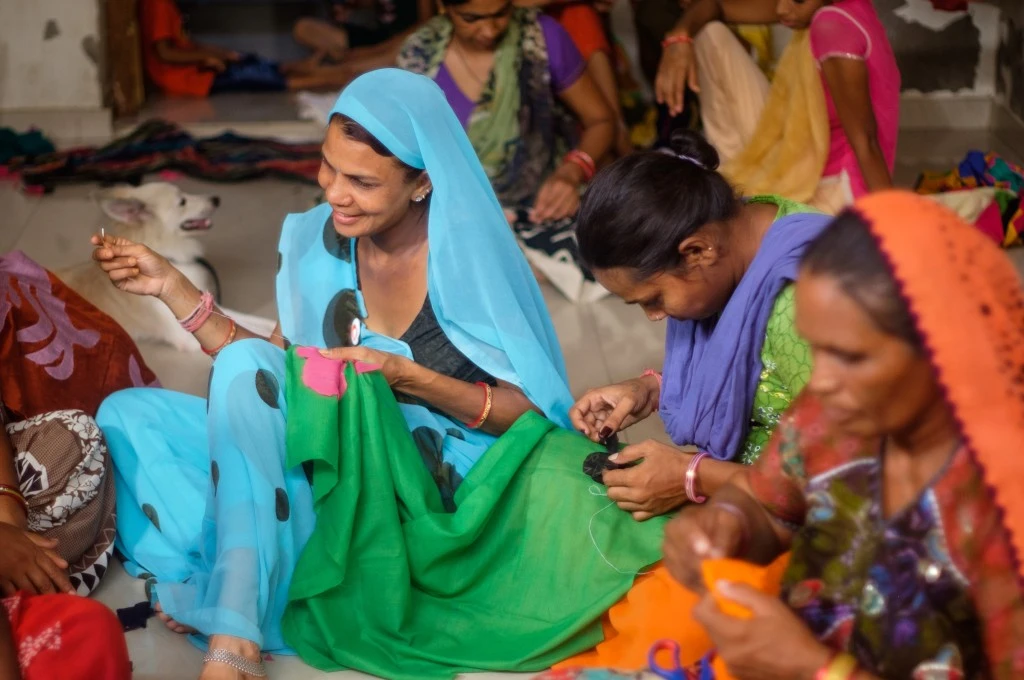Amid a growing push for inclusion, women’s participation in the digital economy continues to be shaped by socio-economic factors such as education, income, digital literacy, care responsibilities, age, and class. Women-led informal businesses come up against multiple interconnected barriers to digital access: Rural businesses face poor internet connectivity and high subscription costs for data and messaging plans, and many women struggle to use the internet for income-generating activities.
The Government of India launched the Open Network for Digital Commerce (ONDC) to make e-commerce accessible to smaller and informal sector businesses without the need for large financial inputs from sellers, advertising-driven visibility, exclusivity clauses, and restrictive platform policies. This would be particularly helpful for informal women-owned businesses that often operate with small margins, low production quantities, and limited capacity for after-sales service.
Bridging the e-commerce gap?
Sellers can join the ONDC through a seller network participant (SNP), which manages their product listings, assists in cataloging inventory, and ensures visibility across the network. SNPs collaborate with buyer network participants (BNPs), which are businesses with strong customer bases that connect buyers to the ONDC via dedicated buyer apps. BNPs have to handle customer inquiries and provide a checkout service across multiple product categories. Some platforms, such as Mystore and Paytm, operate as both SNPs and BNPs, facilitating broader engagement within the network. The ONDC also allows products and services from all sellers registered with different SNPs to appear in search results across buyer apps, as long as these BNPs support that particular product category.
Additionally, the ONDC lets sellers retain control over customer data, set their own return and refund policies, and gain visibility across multiple buyer apps. This open network model has the potential to integrate informal women’s enterprises into digital commerce on fairer terms.
For more than two decades, the SEWA Cooperative Federation (SCF) has served as a decentralised, women-centric enterprise support system (WESS) to promote financial inclusion, incubation, business development, and policy advocacy—supporting 112 women’s collectives so far. Given our experience in enabling market access for women’s collective enterprises, SCF explored the potential of the ONDC by onboarding two of its producer cooperatives: Abodana Handicrafts Cooperative, which works with 394 women artisans in Gujarat to preserve traditional crafts and provide access to market linkages and social security schemes, and Lok Swasthya Mandali (LSM), a healthcare cooperative with more than 1,500 shareholders that provides affordable medicines and health services. The cooperatives’ experiences provide insights into the practical and real-time functioning of small women-led enterprises on the ONDC.
Structural challenges hindering entry and growth on ONDC
While the ONDC has clear guidelines on seller–SNP relations, such as the ONDC Network Policy and Network Participant Agreement, there is insufficient mentoring for smaller enterprises to access and understand such technical documents. Being able to navigate and use a dashboard requires not just digital skills but also a certain level of confidence, adaptability, and curiosity towards technology— all of which can be difficult to instill among women in informal enterprises due to pre-existing barriers and limited time.
1. Exclusionary engagement criteria
The ONDC Academy videos encourage SNPs to engage with newly onboarded sellers based on their current performance and perceived growth potential. While this approach aims to support small sellers, it may disadvantage women-led informal enterprises that often start with low performance, due to limited accessibility to digital marketing knowledge and skills, and low production capacity. As a result, their growth potential may be undervalued by mainstream SNPs. Additionally, the recommended tools for improving seller performance—‘incentives’ and ‘training’, and even ‘warnings’ and ‘penalties’—fail to account for the structural challenges smaller sellers face in adopting digital sales.
This approach also overlooks deeper inequities that hinder participation—such as lack of access to upskilling, understanding of market trends, and adequate manpower—making the system exclusionary rather than supportive. Even if the platform does provide options to grow sales, such as through product bundling and seasonal and festive discounts, informal women’s enterprises may lack the personnel or business know-how to actively seek out and avail these opportunities.
2. Unclear charges and commissions
Sonalben Kathiriya, a business manager at LSM, says, “Sometimes I get invoices in the mail. They are small amounts, but I am not sure what they are for. We can at least be given some context. It is not feasible for us to write mails or contact the admin team for minor clarifications. Their average response time is also very slow.” She adds about the SNP sales dashboard, “These orders are under the RTO (return to origin) category, but there no other information or context is provided.”
LSM is also not clear on how and when the SNP’s commission charges would be levied, as some sales have already taken place. The cooperative’s store rating, as per the SNP, is 2.86—based on fulfillment rate, on-time RTS (ready to ship) rate, on-time delivery rate, order accuracy rate, and customer complaint-free rate. However, they have no information about their performance on individual criteria.

3. Power imbalances between SNPs and small sellers
SNPs hold significant power over small sellers, as they decide how much support to offer in onboarding, cataloging, and sales management. Critical features such as commission fees, inventory management alerts, and user-friendly dashboards are inconsistent across SNPs, limiting seller autonomy. The ONDC lacks clear guidelines on the minimum support or user-friendliness SNPs must provide. While sellers can switch SNPs without losing product visibility (a unique feature of the ONDC), many do not have the knowledge to make informed choices. SNPs are responsible for informing sellers of this flexibility, but sellers may not be able to make the transition independently.
4. Procedural and bureaucratic hurdles
a) Complex onboarding: The onboarding process itself is long and complex. Major bottlenecks for LSM included lack of familiarity with the SNP interface, irregular product categories, difficulties in bulk uploading, errors in store location, and challenges in navigating the sales dashboard.
LSM took six months to complete the onboarding process, despite having a dedicated team member for digital platforms. Abodana, with fewer technical resources, had to rely on SCF for training and ongoing support.
b) Grievance redressal: While the ONDC has grievance officers, small sellers often do not know whom to approach when SNPs fail to provide adequate support. Seller grievances are also not eligible for escalation to the ONDC and must be resolved directly in accordance with the roles and responsibilities provided in the Issue and Grievance Management Policy (IGMP).
Sometimes, the issues are seemingly not big enough to warrant escalation—for example, order delays and cataloging or technical difficulties that can be resolved on a call or over chat. However, in the case of LSM, SCF had to do this on behalf of the cooperative and find the point of contact for the SNP and arrange continuous meetings. There were no follow-ups from the SNP. As of now, the SNP with whom the cooperatives onboarded has a system where the seller can raise a ticket on the dashboard for resolution of issues or support needs. However, small grassroots cooperatives prefer systematic and regular follow-ups throughout the onboarding and initial sales processes so they can ease into the platform.
5. Lack of a dedicated support system
Small sellers without social capital or organisational support may have trouble operating on the ONDC. Both LSM and Abodana needed assistance in reaching out to an ONDC growth manager, who then persuaded the SNP to provide more hands-on support for technical challenges instead of just sharing training material.
6. Poor visibility and sales growth
Despite successfully onboarding onto the ONDC, LSM and Abodana struggled to generate sales. Over seven months, LSM made only eight sales, averaging just one sale per month with a total revenue of INR 1,770. Amishaben, manager at Abodana, says, “We have no idea what to do next. There is no guidance after onboarding.”
While the ONDC eliminates hidden costs like inventory maintenance fees, both cooperatives had little clarity on how sellers can improve product visibility and ranking within buyer apps. Parameters for product listing and visibility, such as minimum photo requirements and search result algorithms, were not adequately explained, leaving them unsure how to optimise their presence on the platform.
At the time of onboarding, the categorisation of products posed significant issues. LSM found that while a health and wellness category existed for manual uploads, it was missing in bulk uploads, making the process cumbersome.
For Abodana, there was no handicrafts category, forcing them to list under ‘fashion’ or ‘home decor’, neither of which accurately represents their products. These mismatches reduced their visibility and risked misleading customers. While this may not be the responsibility of the SNPs themselves, it is a recurring issue at the platform level.

Improving accessibility and usability
Mentoring support, financial assistance, and tailored capacity-building programmes are essential for successful digital integration. In order to ensure that ‘all types and sizes of sellers’ can access e-commerce, we make the following recommendations so the ONDC can be more inclusive:
1. Understanding and spotlighting women-led informal enterprises
Dedicated platforms to engage with and understand the user experience of women’s collective enterprises must be integrated into the ONDC—this will ensure that it is responsive to the needs of these women. This can be mapped out by involving regional nonprofits and grassroots federations, who can also support in onboarding.
One way to make the platform more accessible is to create a tag or category that helps in identifying and featuring women-led grassroots enterprises and service providers. This can be done in the way that the Womaniya tag is used by the Government e-Marketplace. Consumer awareness about the ONDC can also help improve platform engagement, adoption, and trust.
2. Balancing standardisation and flexibility
Seller apps should follow standardised and simplified guidelines for working with nano and small women’s enterprises, including for onboarding processes, which can enhance transparency and accountability towards sellers.
Standardisation should also extend to product categories based on input from small enterprises. There should be guidelines for SNPs to support sellers in finding suitable categories and in the cataloging process. Moreover, the parameters for product listing should be explained in detail as part of the initiation process, and this guidance should be provided throughout the first year until the enterprise is well positioned to manage business processes on its own.
At the same time, production or order fulfillment often varies across small industries due to factors such as weather, market fluctuations, and shortages of specific inputs and raw materials, which can cause delays—especially in sectors like handicrafts and food production. As such, there is a need to balance standardisation with sector-specific flexibility so that such challenges do not negatively impact sellers.
3. Creating minimum support requirements and follow-up assistance
Dedicated support teams, mentoring, and follow-ups are essential to help enterprises navigate the ONDC in terms of engagement, sales growth, and visibility.
“We need help in understanding the algorithm for increasing product visibility. How can we boost our sales? We need continuous training,” says Sonalben when asked about LSM’s requirements from the ONDC. A dedicated onboarding and support team for small enterprises should be mandated within SNPs to ensure sustained engagement. Further, there should be monthly and quarterly follow-ups at the beginning of the enterprise’s journey to assist with marketing needs or technical issues.
For a small grassroots seller, tracking communications through a dashboard or even through e-mails may prove to be exhausting and disincentivising. Online training sessions or calls might be more useful in retaining sellers on the ONDC. Building awareness around the ONDC Academy, which is a good resource hub for training videos in multiple languages, is also a way to improve and maintain engagement.
Training should focus on monitoring of sales, order fulfillment, and digital marketing, which may be difficult to adapt to even for those who are familiar with digital technology. Proper utilisation of dashboard features, following quality requirements to boost visibility and sales, and other strategies to ensure small sellers can sustain their presence on the ONDC are some points that can be prioritised in training.
4. Making SNPs accountable
Formalising SNP–enterprise agreements in the form of a memorandum of understanding (MoU) will ensure that the enterprise has more control and information about the terms and conditions of operating on the SNP. Additionally, monitoring indicators should be established to track SNPs’ effectiveness in integrating informal women’s enterprises, including metrics on sales growth, seller retention, and grievance resolution.
While the ONDC was conceived as an alternative e-commerce platform that could be more accessible for small entrepreneurs and enterprises, structural barriers create the risk of replicating disparities prevalent in other digital marketplaces. In order to truly level the playing field, the platform must provide hands-on support and introduce policies and practices that can meaningfully address the needs of small-scale sellers.
Amisha Darbar, Subhamayi Subhashree Das, and Sonal Kathiriya contributed to this article.
This article was updated on June 16, 2025 to incorporate information about the SCF’s Abodana and Lok Swasthya Mandali (LSM) producer cooperatives.
—
Know more
- Read more about the challenges faced by Indian artisans in accessing e-commerce platforms.
- Understand how the digital divide worsens existing inequalities in India.
- Learn how low digital literacy impacts employment opportunities for women.





